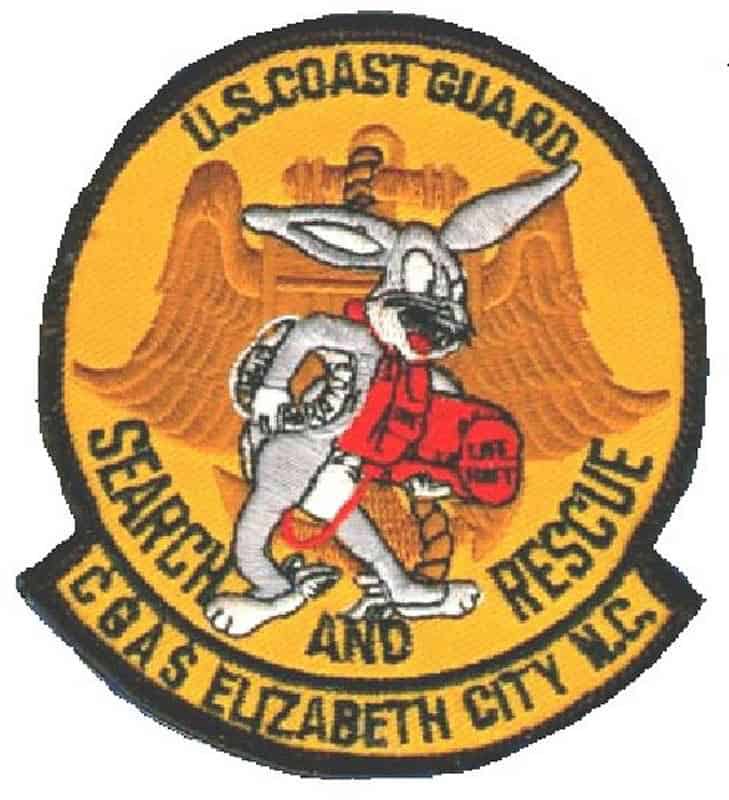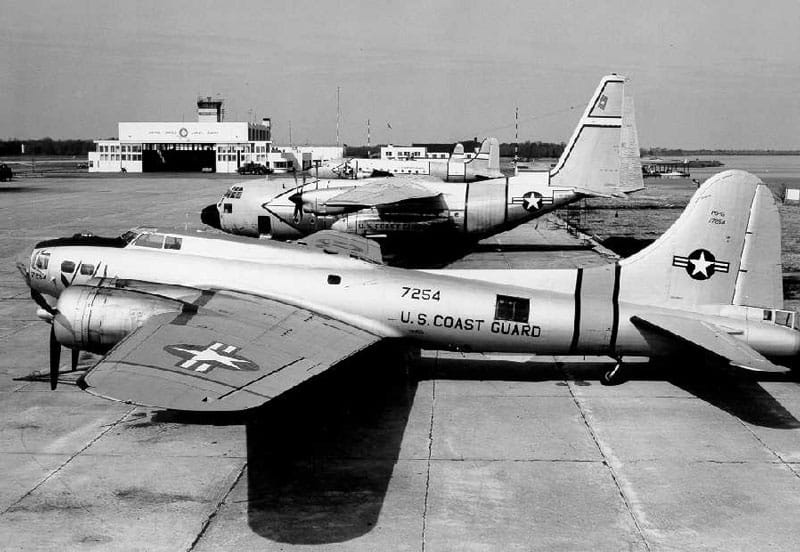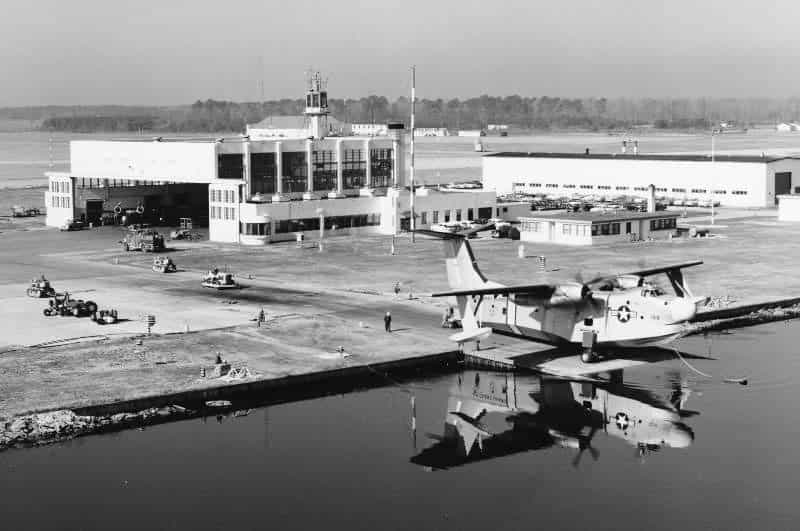 An Act of Congress approved by President Wilson on August 29, 1916 authorized the Secretary of the Treasury to establish a total of 10 Coast Guard air stations distributed along the coast line of the United States. Unfortunately the Act made no provisions for funding. During the 1934-1939 time period a number of Coast Guard air stations were established utilizing federal public works funding. In 1938 a combination of circumstances took place that would establish a Coast Guard air station at Elizabeth City, North Carolina. Located sixty miles north of Cape Hatteras, north of Albemarle Sound and along the east coast’s northern most ice-free river, the old Holowell Plantation near Elizabeth City was selected by the Coast Guard for its potential strategic value as a seaplane base.
An Act of Congress approved by President Wilson on August 29, 1916 authorized the Secretary of the Treasury to establish a total of 10 Coast Guard air stations distributed along the coast line of the United States. Unfortunately the Act made no provisions for funding. During the 1934-1939 time period a number of Coast Guard air stations were established utilizing federal public works funding. In 1938 a combination of circumstances took place that would establish a Coast Guard air station at Elizabeth City, North Carolina. Located sixty miles north of Cape Hatteras, north of Albemarle Sound and along the east coast’s northern most ice-free river, the old Holowell Plantation near Elizabeth City was selected by the Coast Guard for its potential strategic value as a seaplane base.
The Coast Guard Air Station Elizabeth City was commissioned on August 15, 1940 with four officers, 52 enlisted men and ten aircraft including three Hall PH-2 seaplanes, four Fairchild J2K landplanes, and three Grumman JF-2 amphibians. The assigned mission was two fold; the preservation of life and property at sea and the assumption of Neutrality Patrol duties which had been a responsibility of the Coast Guard air station at Charleston, South Carolina. By Executive Order the United States Coast Guard was transferred from the Treasury Department to the U. S. Navy on 1 November 1941 and on December 7, 1941 the United States became fully involved in World War II.
Spurred by the demand of war, the station was in a rapid state of expansion and served as a training base for both Army and Navy personnel, as well as a base for Coast Guard coastal patrols. Consolidated Vultee had an assembly plant for RCAF lend lease PBY-5As. In 1944 a Top Secret covert training/procurement program named Project Zebra trained Russian aviators and crew members for ASW operations utilizing PBN-1 Nomads. (PBY-5A aircraft built by the Naval Aircraft Factory). More than 100 PBN-1s were flown out of Elizabeth City bound for The Soviet Union.
Initially there were very few resources available to combat the German submarines. The Coast Guard aircraft, not designed for combat, were equipped with locally fabricated depth charge racks and pressed into service. During the first six months of 1942 resources were strained in a concentrated effort to rescue survivors of torpedoed ships. In March the OS2U Kingfishers arrived. When coastal shipping was organized in convoys after April, 1942, the Elizabeth City Air Station was designated to furnish an escort in its assigned area. This proved to be effective.
Navy Fleet Air Wing Five deployed three PBYs to the station in May 1943 to transition Coast Guard aviators to this type aircraft. After the establishment of VP-6 in Greenland initial training for replacement crews was conducted at Elizabeth City. The first adequate aircraft designed for anti-submarine warfare to be assigned to the station were the PBMs, the first of which arrived 5 December 1943.
The submarine menace along the East Coast had subsided materially by this time as the German Navy redeployed their submarine assets to the North Atlantic.

Search and rescue became the primary mission in 1944. PBYs and PBMs were the initial aircraft; PBIG long range search aircraft came on board in 1946; the P5Ms in 1954; R5Ds in 1958 followed by the C-130s in 1960. The operational helicopters arrived in 1948 with the assignment of two HRPs. The HO3Ss followed which were in turn followed by the HO4Ss; the HH-52s; the HH-3Fs and then the HH-60J. The capabilities of the rescue aircraft has increased exponentially.
The HH-60J and later model MH-60T medium range recovery helicopters are outfitted with the most comprehensive all weather electronics package available. Aircrews consist of two pilots, a hoist operator and rescue swimmer. These crews have access to an array of equipment that increases their ability to detect persons and vessels in the water, including forward looking infrared radar (FLIR), direction finding (DF) radio equipment, and night vision goggles. Rescue swimmers are experienced in many different environments. Along with their rescue abilities they are also nationally registered Emergency Medical Technicians.
The C-130 long-range surveillance aircraft are also equipped with extremely effective radio and navigation packages. Aircrews consist of two pilots, a flight engineer, navigator, radio operator, and dropmaster. The aircrews have an assortment of rescue equipment aboard that can be deployed by parachute including life rafts, radios, survival kits, pumps, and survival suits.
Since 1995 the Air Station has averaged over 360 search and rescue missions each year. In the last 60 years the Air Station has launched on over 20,000 missions, day and night, fair weather or foul, to rescue or assist over 10,000 people.
In April 1946, a repair and supply facility was added to the Air Station. By 1948 it had expanded and became a separate Headquarters Unit. In 1949 training enlisted personnel in some aviation rates become another responsibility. The training facilities were later expanded and consolidated into an independent command. In 1964, the Fifth Coast Guard District established Air Base Elizabeth City and in 1966 the Air Base expanded after absorbing the air stations located in Bermuda and Argentia, Newfoundland. Since the closure of Argentia C-130 aircraft based out of Elizabeth City have been the chief air support for the International Ice Patrol.
The Atlantic Strike Force was welcomed aboard in 1973. This is a cutting-edge force of personnel and equipment whose purpose is to facilitate preparedness and response to oil and hazardous pollution incidents. Since 1976 there has been a dramatic increase in Drug Interdiction, Fisheries Enforcement, and Alien Interdiction Operations.
With the transfer of the Coast Guard to the Department of Homeland Security the Coast Guard developed the Maritime Security Response Team. This is a counter terrorism force with advanced interdiction capabilities. The team is supported by an aviation detachment in Elizabeth City, N.C., as well as a Helicopter Interdiction Tactical Squadron (HITRON) in Jacksonville, Fl.
The Elizabeth City complex continues to play a vital role in Coast Guard Aviation.

